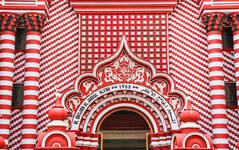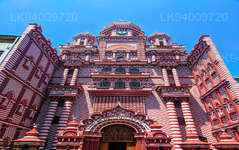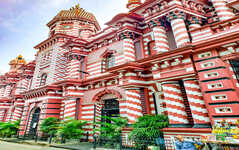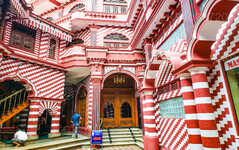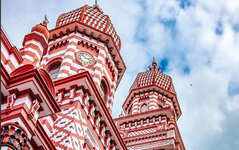
Colombo City
Colombo, hovedstaden i Sri Lanka, er en dynamisk by, der blander tradition og modernitet. Den fremviser kolonial arkitektur, livlige markeder og fredfyldte buddhistiske templer. Med et varieret køkken, en voksende skyline og smukke strande er det et pulserende knudepunkt for forretning, kultur og turisme, der tilbyder en indgang til at udforske Sri Lankas vidundere.
Red Mosque
The Jami Ul-Alfar Mosque, also known as the Red Mosque (not to be confused with the Red Mosque of New Delhi), is one of Colombo’s oldest mosques. The Arabs arrived for the first time in Sri Lanka for trade in the 7th century AD. As olden days Ceylon was a hub for trade and was right in the middle of the spice and silk routes; they maintained a constant presence in Sri Lanka since that time by either migrating or intermarrying with the locals. Most Islamic communities settled in Colombo or Galle where the main ports were located; and to this day their descendants continue their lives in these areas. And hence as a result Colombo, with its being a major trade zone of the country, has a very big population of Muslims. But there was a severe lack of large mosques, which made life very difficult for the local Islamic community as their religion enforced praying 5 times a day.
The Jami Ul-Alfar Mosque was built in 1908 in Pettah to cater to the growing need for a large place for religious repose. The design and construction were done by Habibu Labbe Saibu Labbe an unknown architect of the time. He used Indo-Saracenic structural images, given to him by the South Indian traders who commissioned him, as his base; but also mixed in elements of his own. One of the most notable architectural changes is that the dome-shaped spires on top of the mosque are not of the typical onion shape. Instead, its shape follows that of a pomegranate; while its walls are painted the same shade of red as the innards of that fruit, along with pale yellow horizontal stripes. This red tone is why the mosque gained its nickname. The mosque had approximately two floors (unsure of the exact amount as renovations were done later, and the locals in the know-how refuse to speak much about its history) at the time; which were supported by four massive teak tree columns that pass through the two lower floors.The construction was completed in 1909 and the mosque could hold a capacity of 1500 people; though only about 500 attended regularly there at that time. However, the numbers grew swiftly and in 1975 the Haji Omar Trust took control of the surrounding properties and began the work of expanding the mosque.
In 2007, there was a new four-storied wing built, allowing the mosque to increase its capacity to 10,000. Today the mosque continues to update and refurbish its facilities.
Visitors are greeted by beautiful minarets and spires straight from a Persian fairytale, which is seen for miles all around. The bright red and pale yellow stripes of its walls make the mosque stand out in the crowded street with all its shops and buildings of trade and business. The tiles of the inner part of the mosque have been replaced with those that have an early 20th century Period design; which gives the entire area a beautifully aged aura. The four teak support columns are still there in pristine condition. The mosque doesn’t skimp on modern-day facilities though; and was most recently having an escalator facility built for elderly and infirm visitors.
However, there seems to be a ban on Muslim women to visit the mosque due to religious restrictions. As there have been many who requested a section for the women; there appears to plan for such a section, where women can do their prayers, to be built in the future.
Though the Red Mosque is an Islamic religious facility, visitors from other religions are eagerly welcomed.
Om Colombo-distriktet
Colombo er Sri Lankas største by og handelshovedstad. Den ligger på øens vestkyst og støder op til Sri Jayewardenepura Kotte, Sri Lankas hovedstad. Colombo er en travl og pulserende by med en blanding af moderne liv og koloniale bygninger og ruiner og en bybefolkning på 647.100. Colombo Metropolitan Region, defineret af distrikterne Colombo, Gampaha og Kalutara, har en anslået befolkning på 5.648.000 og dækker et areal på 3.694,20 km². Colombo er en multietnisk, multikulturel by. Det er den mest folkerige by i Sri Lanka med 642.163 mennesker, der bor inden for bygrænsen. Befolkningen i Colombo er en blanding af adskillige etniske grupper, primært singalesere, maurere og tamiler. Der er også små samfund af mennesker med kinesisk, portugisisk, hollandsk, malaysisk og indisk oprindelse, der bor i byen, samt adskillige europæiske udlændinge. Langt de fleste srilankanske virksomheder har deres hovedkontorer i Colombo. Nogle af industrierne omfatter kemikalier, tekstiler, glas, cement, lædervarer, møbler og smykker. I byens centrum ligger Sydasiens næsthøjeste bygning - World Trade Center.
Om Vestprovinsen
Vestprovinsen er den tættest befolkede provins i Sri Lanka. Den er hjemsted for den lovgivende hovedstad Sri Jayawardenepura Kotte samt Colombo, landets administrative og forretningsmæssige centrum. Vestprovinsen er opdelt i 3 hoveddistrikter kaldet Colombo (642 km²), Gampaha (1.386,6 km²) og Kalutara (1.606 km²). Som Sri Lankas økonomiske centrum er alle de store lokale og internationale virksomheder til stede i byen, ligesom alle de store designer- og detailhandlere, så vær klar til at forkæle dig selv med lidt shoppingterapi i den vestlige provins. Med den højeste befolkning i alle provinser er næsten alle de førende uddannelsesinstitutioner på øen placeret i den vestlige provins. Universiteterne i provinsen omfatter University of Colombo, University of Sri Jayewardenepura, University of Kelaniya, Open University, Sri Lanka, Buddhist and Pali University of Sri Lanka, General Sir John Kotelawala Defence University og University of Moratuwa. Den vestlige provins har det største antal skoler i landet, herunder nationale, provinsielle, private og internationale skoler.

